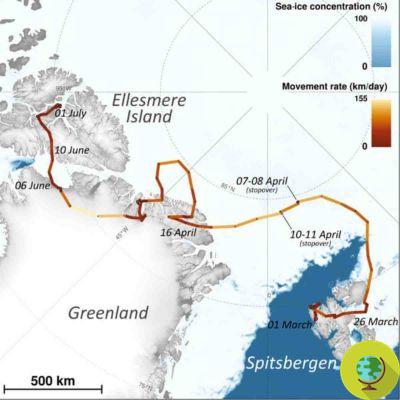The very long journey of a one-time arctic fox that walked more than 3.500 kilometers from Norway to Canada in just 76 days.
He is about to end up run over, his mother saves himA arctic fox walked more than 3.500 km from Norway to Canada in just 76 days: this is the astonishing news coming from the Norwegian Polar Institute, which had equipped the animal with a tracking device since July 2017. But now the event leaves much discussion on the role of climate change.
Known as "coastal fox" or "blue", the spectacular beast left Spitsbergen, in the Norwegian archipelago of Svalbard, on March 26, 2018. After 21 days and 1.512 km on sea ice, it arrived in Greenland in April 2018. And her journey continued to Ellesmere Island, Canada, where she arrived in these hours.
"We didn't think it was true at first," said researcher Eva Fuglei, who tracked down the female fox.
According to the Institute's research paper titled "A Female's Run Through Sea Ice", the arctic fox's journey was among the longest on record. It was so long, in fact, that researchers initially wondered if the fox's collar could be removed and taken aboard a boat.
“But no, there are no boats that go that far in the ice. So we just had to keep up with the fox, ”Fuglei explained.
And so the collar transmitted data for a period of three hours a day. Moving between ice and glaciers, the fox moved at an average of 46,3 km per day and traveled 155 km in one day, when it was on the North Greenland ice sheet.
The arctic fox migrated via sea ice from #Svalbard in Europe to #Canada in North America at a pace no researchers have previously documented. Photo: Elise Stømseng Read more: https://t.co/Gk3xirq3YE pic.twitter.com/adzOVNFfyx
- Norwegian Polar Institute // Norwegian Polar Institute (@NorskPolar) June 26, 2019
Researchers think the large amount of land covered on that day could indicate that the fox used sea ice as a "means of transportation."
"Sea ice plays a key role in mountain foxes migrating between areas, encountering other populations and finding food," said Fuglei, adding that it was the first time they have documented species migration in detail between continents and ecosystems in the Arctic.
The Fox's Journey has raised concerns about how the influence of climate change on sea ice could impact the migration capacity of animals.
"This is another example of how important the presence of sea ice is in nature in the Arctic," said Norwegian climate and environment minister Ola Elvestuen. Warming up in the north is frighteningly fast. We need to cut emissions quickly to prevent sea ice from disappearing throughout the summer ”.

The fox has been tracked down to an area where it would have survived thanks to marine food resources, including seabirds. Instead, in the place where she settled on the island of Ellesmere, she lived mainly on lemmings (lemmings, small arctic rodents) indicating her ability to change ecosystems. In winter, when food is scarce, Arctic foxes sometimes eat the food left over by polar bears.
Arctic foxes are incredibly hardy animals that can survive brutal freezing temperatures of up to 50 ° C. The animals have furred paw legs, short ears, and a short snout to help them manage cold climates.
The fox's final fate is unknown: its GPS tracker stopped working in February of this year.
Read also:
The thrilling escape of 14 macaques from a zoo in Japan
More than 500 endangered vultures poisoned in Africa


























